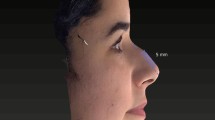Abstract
Background
Resection of the nasal hump is one of the most critical steps of the rhinoplasty procedure, which is quite prone to complications when performed improperly or inappropriately. In this article, a practical, facile and minimally traumatic hump resection technique using Kazanjian bone-cutting forceps is presented with excellent cosmetic and functional results.
Methods
Fifty-seven consecutive primary (septo-)rhinoplasty patients with wide nasal bases, and various sizes of nasal humps, were enrolled in the study. Following reduction of the cartilaginous dorsum height, L-strut shaping of the septum, and septoplasty procedures, Kazanjian bone-cutting forceps were used for resection of the bony nasal hump. Lateral osteotomies were then performed, and the surgery was completed following insertion of the structural grafts, tip procedures and turbinate surgery. A computer software was used to measure the nasal hump. The “Rhinoplasty Outcome Evaluation” questionnaire was used to evaluate patient satisfaction 12 months after the operation.
Results
The technique presented here was performed on 19 male and 38 female patients with a mean age of 24.95 ± 6.07 years. The mean height of the nasal hump was 4.65 ± 1.56 mm. No patient had complications requiring further corrective surgery. The “Rhinoplasty Outcome Evaluation” questionnaire showed that all patients remained in the group of happy subjects.
Conclusions
Long-term patient satisfaction indicates that the proposed technique could be used as an alternative procedure to other hump resection techniques. The technique described is an effective, reliable and atraumatic method of resection of any size nasal hump.
Level of Evidence V
This journal requires that authors assign a level of evidence to each article. For a full description of these Evidence-Based Medicine ratings, please refer to the Table of Contents or the online Instructions to Authors http://www.springer.com/00266.







Similar content being viewed by others
References
Jin HR, Won TB (2007) Nasal hump removal in Asians. Acta Oto Laryngol Suppl 558:95–101
Lee MR, Unger JG, Rohrich RJ (2011) Management of the nasal dorsum in rhinoplasty: a systematic review of the literature regarding technique, outcomes, and complications. Plast Reconstr Surg 128:538e–550e
Holt GR, Garner ET, McLarey D (1987) Postoperative sequelae and complications of rhinoplasty. Otolaryngol Clin North Am 20:853–876
Rohrich RJ, Muzaffar AR, Janis JE (2004) Component dorsal hump reduction: the importance of maintaining dorsal aesthetic lines in rhinoplasty. Plast Reconstr Surg 114:1298–1308
Halewyck S, Michel O, Daele J, Gordts F (2010) A review of nasal dorsal hump reduction techniques, with a particular emphasis on a comparison of component and composite removal. B-ENT Suppl 15:41–48
Esenlik E, Kaya B, Gülsen A, Çukurluoğlu O, Özmen S, Yavuzer R (2011) Evaluation of the nose profile after maxillary advancement with impaction surgeries. J Craniofac Surg 22:2072–2079
Alsarraf R (2000) Outcomes research in facial plastic surgery: a review and new directions. Aesthet Plast Surg 24:192–197
Izu SC, Kosugi EM, Brandão KV, Lopes AS, Garcia LBS, Suguri VM, Gregório LC (2012) Normal values for the Rhinoplasty Outcome Evaluation (ROE) questionnaire. Braz J Otorhinolaryngol 78:76–79
Vermeiren J, De Vos G (2006) The feather touch rasp, a powered instrument for hump reduction. B-ENT 3:113–117
Davis RE, Raval J (2003) Powered instrumentation for nasal bone reduction: advantages and indications. Arch Facial Plast Surg 5:384–391
Pribitkin EA, Lavasani LS, Shindle C, Greywoode JD (2010) Sonic rhinoplasty: sculpting the nasal dorsum with the ultrasonic bone aspirator. Laryngoscope 120:1504–1507
Avşar Y (2009) Nasal hump reduction with powered micro saw osteotomy. Aesthet Surg J 29:6–11
Becker DG (2002) The powered rasp: advanced instrumentation for rhinoplasty. Arch Facial Plast Surg 4:267–268
Goldman IB (1953) Angular bone-cutting forceps for rhinoplasty. AMA Arch Otolaryngol 58:744
Goumain J (1974) Cutting forceps for lateral osteotomy in rhinoplasty. Plast Reconstr Surg 53:358–359
Seyhan A (2012) Management of the lateral walls in crooked nose. World J Plast Surg 1:112–115
Neuner O (1971) A simple procedure for correction of the hump nose. Br J Plast Surg 24:375–381
Kazanjian VH, Holmes EN (1947) New rongeur for removing a nasal hump. Arch Otolaryngol 45:361–364
Rowland AL (1955) A new cross-action nasal hump rongeur. Plast Reconstr Surg 15:509–511
Barton RT (1952) Use of the Kazanjian rongeur in rhinoplastic surgery. AMA Arch Otolaryngol 55:478–483
Daniel RK (2010) Mastering rhinoplasty: a comprehensive atlas of surgical techniques with integrated video clips. Springer, Berlin
Pearlman SJ, Talei BA (2012) An anatomic basis for revision rhinoplasty. Facial Plast Surg 28:390–397
Author information
Authors and Affiliations
Corresponding author
Ethics declarations
Conflict of interest
The authors declare that they have no conflict of interest.
Ethical Standards
All procedures performed in this study were in accordance with the ethical standards of the institutional and/or national research committee, and with the 1964 Helsinki declaration and its later amendments or comparable ethical standards.
Rights and permissions
About this article
Cite this article
Yontar, Y., Tatar, S. A Practical Technique for Reduction of the Bony Nasal Dorsum Height Using Kazanjian Bone-Cutting Forceps. Aesth Plast Surg 41, 126–134 (2017). https://doi.org/10.1007/s00266-016-0737-3
Received:
Accepted:
Published:
Issue Date:
DOI: https://doi.org/10.1007/s00266-016-0737-3




